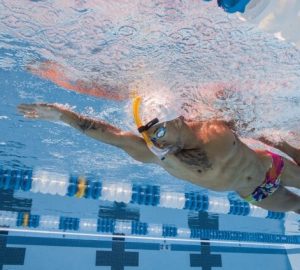Should race organisers be encouraging people to swim in the Thames?
Earlier this week I interviewed Nick Rusling, CEO of Human Race, one of the UK’s largest open water swimming event organisers (see our Aug/Sep 2013 Issue for this).
Many readers will be aware that Human Race put on several events involving swimming in the River Thames, and have been doing so since 1990 and the first Windsor Triathlon. The Thames however is not an official bathing water and, according to a recent report from Public Health England (PHE), is “known to be regularly contaminated with human pathogens.”
As regular swimmers, and David Walliams, could tell you, swimming in the Thames can make you ill.
So should race organisers be encouraging people to swim in the Thames?
Last October Human Race put on a swim from Hampton Court to Kingston Bridge. The event had already been postponed from the summer because of extreme weather conditions. On the day of the swim the river was also flowing fast (see our estimate on how fast here) but after carrying out a risk assessment, Human Race decided the event could go ahead.
Among other things, the risk assessment looked at water quality and water conditions. With the latter, one of Human Race’s criteria is the ease with which they could carry out a rescue if necessary.
“We put the safety team in the water and carried out a practical test to ensure we would be able to rescue a swimmer,” says Rusling.
As for water quality testing, Human Race took samples on 5 October, two days before the event, and also on race day. These were tested by a private laboratory in London for “nitrates, carbonates, Escherichia coli (as an indicator of faecal contamination) and blue green algae.”
No concerns were raised by the testing but as Rusling accepts, the Thames is a moving body of water and what was tested was not necessarily the same as what was swum in.
And clearly that day, something nasty was in the water as swimmers soon started reporting nausea, stomach cramps, vomiting and diarrhoea. Eight people visited their hospital’s Accident and Emergency wards and four people ended up staying overnight. Fortunately, for most people the symptoms cleared up quickly without any need for medical intervention.
In a subsequent investigation, PHE found that 338 swimmers became ill – and we know of at least one swimmer who became ill and didn’t complete the survey, so the real number is higher – out of 1,100 participants. (You can see the report and its recommendations here.)
What this episode illustrates is that open water swimming is not ‘safe’. At least, not in the way that we seem to understand ‘safe’ today – that there are no risks whatsoever. We are sometimes asked, “is open water swimming safe?” and I get the feeling we are expected to answer either “yes” or “no”.
A “yes” answer would imply that you can swim and there’s absolutely no chance anything bad will happen to you, ever, while “no” indicates you will be attacked by rogue sharks (in the Thames), suffer a heart attack and contract Weil’s disease immediately you enter the water.
Sensible swimmers know life isn’t like that but when we enter official events we expect the organisers to take reasonable steps to ensure our safety.
But what is reasonable? Does it mean holding swimming events only in approved official bathing waters meeting the highest European Union standards? Or is it acceptable to use other water bodies?
At the moment there is no universally agreed water quality standard for open water swimming events. Event organisers have to make their own risk assessments.
“One of our aims is to help support people with their passions,” says Rusling. “But we do have to acknowledge that the water may not be perfectly clean.”
Human Race doesn’t force people to swim in the Thames but provides an opportunity to do so. The stretch of water from Hampton Court to Kingston Bridge is an enjoyable portion of the river to swim, but it is also very busy with rowers, kayakers and pleasure boats and so swimming there outside of an organised event is probably more risky.
But should the entire burden for reducing risk be dropped into the lap of the organisers anyway or should swimmers also take responsibility for their own health and safety?
One of the PHE report’s recommendations was that swimmers should wash their hands after swimming and especially before eating. Most swimmers probably knew this already but a large number didn’t do it. Organisers can make hand washing easier by providing appropriate facilities (which Human Race will now do at future events, as well as providing wetsuit rinsing facilities, another of the report’s recommendations) but forcing people to wash their hands is harder.
Clearly the health and safety burden is one that needs to be shared between swimmers and organisers, but swimmers’ behaviour will have the biggest impact. Most of the steps you can take to minimise risk are simple, common sense and low cost. Secondly, if you don’t think organisers have created the right safety environment, let them know. They need you and should respond to your concerns. If not, go somewhere else. There are plenty of swims to choose from.
So, to answer the question above, we think it’s a positive thing that event organisers facilitate open water swimming in the Thames, but as usual, we’d love to hear your views.
This year’s Hampton Court to Kingston Bridge swim is on 21 July. Find out more and enter.






